Blog
Heel Pain Can Be Treated!
Efficiency in Walking and Running Differ

The way the foot meets the ground differs in walking and running. Generally, the heel touches the ground first and the weight then rolls onto the ball of the foot and toes during walking. In fact, studies show that walking onto the ball of the foot takes about 50 percent more energy and walking on the toes takes about 80 percent more energy. Heel-first walking is considered to be the most economical way to move. However, this economy of movement does not necessarily transfer to running, some believe. Studies have shown that it is more efficient to land on the toes or ball of the foot while running, rather than on the heel first. In fact, the fastest runners in the animal kingdom – horses, gazelles, deer, and dogs – all land on their toes first. Many elite human runners, both sprinters and distance, do not land on their heels first. That said, many experts agree that your natural strike pattern, toe first or heel first, should remain constant, as it is less efficient to try to convert from one to the other. For more information on the effects of walking or running on your feet, please consult a podiatrist.
If you have any concerns about your feet, contact Dr. Tupper from Coshocton Foot Health Center. Our doctor can provide the care you need to keep you pain-free and on your feet.
Biomechanics in Podiatry
Podiatric biomechanics is a particular sector of specialty podiatry with licensed practitioners who are trained to diagnose and treat conditions affecting the foot, ankle and lower leg. Biomechanics deals with the forces that act against the body, causing an interference with the biological structures. It focuses on the movement of the ankle, the foot and the forces that interact with them.
A History of Biomechanics
- Biomechanics dates back to the BC era in Egypt where evidence of professional foot care has been recorded.
- In 1974, biomechanics gained a higher profile from the studies of Merton Root, who claimed that by changing or controlling the forces between the ankle and the foot, corrections or conditions could be implemented to gain strength and coordination in the area.
Modern technological improvements are based on past theories and therapeutic processes that provide a better understanding of podiatric concepts for biomechanics. Computers can provide accurate information about the forces and patterns of the feet and lower legs.
Understanding biomechanics of the feet can help improve and eliminate pain, stopping further stress to the foot.
If you have any questions please feel free to contact our office located in Coshocton, OH . We offer the newest diagnostic and treatment technologies for all your foot and ankle needs.
The Severity of Ankle Fractures
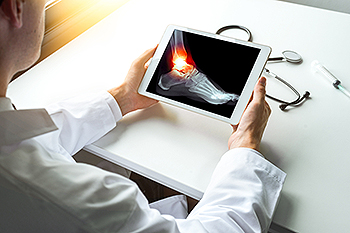
A fracture is when a bone breaks or cracks. When it comes to the ankle, three different bones can be fractured: the tibia (the larger of the two bones in the lower leg), the fibula (the thinner of the two bones in the lower leg), and the talus (the wedge-shaped bone deep inside the ankle). The most common way an ankle can break involves a sharp twist of the ankle or a direct impact to the ankle, causing a fracture to one of the ankle bones. Athletes are at a high risk for ankle fractures. Such a fracture can be particularly dangerous if a bone pokes through the skin and is exposed to the air as the open wound allows bacteria to affect the broken bone and increases risk of infection. Symptoms of a broken ankle include pain, swelling, and bruising of the ankle joint. There will often be an inability to move the ankle normally and to bear weight on it. If you think you have fractured your ankle, see a podiatrist as soon as possible for a proper evaluation and treatment.
Broken ankles need immediate treatment. If you are seeking treatment, contact Dr. Tupper from Coshocton Foot Health Center. Our doctor can provide the care you need to keep you pain-free and on your feet.
Broken Ankles
A broken ankle is experienced when a person fractures their tibia or fibula in the lower leg and ankle area. Both of these bones are attached at the bottom of the leg and combine to form what we know to be our ankle.
When a physician is referring to a break of the ankle, he or she is usually referring to a break in the area where the tibia and fibula are joined to create our ankle joint. Ankles are more prone to fractures because the ankle is an area that suffers a lot of pressure and stress. There are some obvious signs when a person experiences a fractured ankle, and the following symptoms may be present.
Symptoms of a Fractured Ankle
- Excessive pain when the area is touched or when any pressure is placed on the ankle
- Swelling around the area
- Bruising of the area
- Area appears to be deformed
If you suspect an ankle fracture, it is recommended to seek treatment as soon as possible. The sooner you have your podiatrist diagnose the fracture, the quicker you’ll be on the way towards recovery.
If you have any questions, please feel free to contact our office located in Coshocton, OH . We offer the newest diagnostic and treatment technologies for all your foot care needs.
Foot Massage Benefits
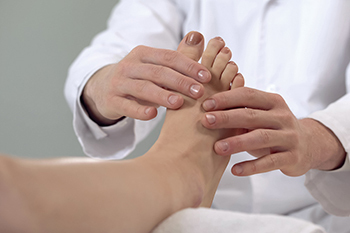
One of the benefits of getting regular foot massages is the overall feeling it can have on the body. It is known to promote blood circulation which may help prevent unwanted foot conditions. Additionally, there are pressure points in the feet that are connected to specific organs in the body, and this can be beneficial in relaxing the muscles and reducing stress. There are various categories of foot massages. A deep tissue massage is done by applying forceful pressure that can reach the muscle layers and connective tissue. This may help people who have endured an injury or who may have painful joints. Diabetic patients can often benefit from having a Thai foot massage performed which may help to increase their range of motion in addition to improving balance. The most common form of massage is known as the Swedish foot massage and the feet can become energized. If you are interested in foot massages and would like to know which one is best for you, please consult with a podiatrist who can answer any questions you may have.
Foot therapy is often necessary for those recovering from either foot deformities or foot injuries. If you have concerns regarding therapy, consult with Dr. Tupper from Coshocton Foot Health Center. Our doctor can provide the care you need to keep you pain-free and on your feet.
Most Common Injuries
People who are active or athletes are prone to a variety of injuries. Therefore, it is often important to take part in physical therapy in order to quickly get back on the right track.
What to Do When Injured
Physical Therapy – This specialized treatment will focus on the affected area, speeding up recovery and the overall healing process. It is a proven method that has helped millions of people return from any injury.
During physical therapy you will undergo regimented training to get back into full form. Training is often very difficult, especially at first when the foot feels weak. Physical therapy often involves:
Basic stretching and twisting exercises – getting the feet’s mobility and flexibility up.
Massaging – the therapist will massage the injured area in order to activate the muscles and relax them.
Strengthening Exercises – this allows the muscles in the affected area to regain their full strength, a vital step towards full recovery.
If you have any questions please feel free to contact our office located in Coshocton, OH . We offer the newest diagnostic tools and technology to treat your foot and ankle needs.
Stretches May Help Before Walking
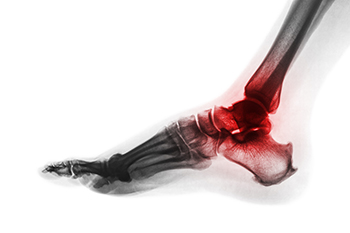
Research has shown that one of the best things you can do if you have arthritis in your feet is to walk as much as possible. This may cause pain to the feet and ankles, despite being overall beneficial. Performing stretches and exercises may strengthen the feet, possibly reduce arthritis symptoms, and this may be helpful to do before walking. An effective exercise is done by spreading marbles on the floor, followed by sitting on a chair. The marbles are picked up one at a time using the toes, and placed into a cup. Many patients find relief when their foot is placed on top of a tennis ball, and the entire foot is rolled on it. This can be beneficial in strengthening the soles of the feet. There are some patients that notice that as their feet become stronger, their arthritis symptoms may decrease. If you would like information about additional stretches to perform that can help arthritic feet, please confer with a podiatrist.
Arthritis can be a difficult condition to live with. If you are seeking treatment, contact Dr. Tupper from Coshocton Foot Health Center. Our doctor can provide the care you need to keep you pain-free and on your feet.
Arthritic Foot Care
Arthritis is a joint disorder that involves the inflammation of different joints in your body, such as those in your feet. Arthritis is often caused by a degenerative joint disease and causes mild to severe pain in all affected areas. In addition to this, swelling and stiffness in the affected joints can also be a common symptom of arthritis.
In many cases, wearing ill-fitting shoes can worsen the effects and pain of arthritis. Wearing shoes that have a lower heel and extra room can help your feet feel more comfortable. In cases of rheumatoid arthritis, the arch in your foot may become problematic. Buying shoes with proper arch support that contour to your feet can help immensely.
Alleviating Arthritic Pain
- Exercises that stretch the foot can prevent further pain and injury and increase mobility
- Most of the pain can be alleviated with anti-inflammatory drugs, heat, and topical medications
- Massages can help temporarily alleviate pain.
It is best to see your doctor for the treatment that is right for your needs and symptoms. Conditions vary, and a podiatrist can help you determine the right method of care for your feet.
If you have any questions, please feel free to contact our office located in Coshocton, OH . We offer the newest diagnostic tools and technology to treat your foot and ankle needs.
Reminder: When Was the Last Time...?
Common Symptoms of Sesamoiditis
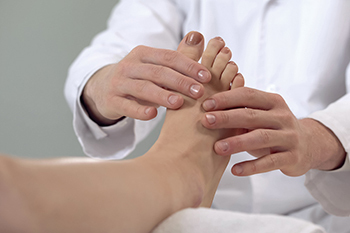
A foot injury can lead to inflammation and irritation of the sesamoid bones which is known as sesamoiditis. Prompt medical attention is often needed and failure to do so may lead to additional inflammation of the surrounding tendons and ligaments. The pain of this foot condition is often felt in the ball of the foot directly under the joint in the big toe. It can be difficult to walk, and the pain may intensify when the big toe is stretched. Many patients often have a limited range of motion in the big toe, and it may be hard to straighten the toe. Sesamoiditis can occur when the pressure on the ball of the foot is increased, and this may happen from frequently participating in running and jumping activities. Existing foot structures like high arches and bony feet may contribute to sesamoiditis. If you have pain in this part of your foot or exhibit any of the above symptoms, please consult with a podiatrist who can effectively diagnose and treat sesamoiditis.
Sesamoiditis is an unpleasant foot condition characterized by pain in the balls of the feet. If you think you’re struggling with sesamoiditis, contact Dr. Tupper of Coshocton Foot Health Center. Our doctor will treat your condition thoroughly and effectively.
Sesamoiditis
Sesamoiditis is a condition of the foot that affects the ball of the foot. It is more common in younger people than it is in older people. It can also occur with people who have begun a new exercise program, since their bodies are adjusting to the new physical regimen. Pain may also be caused by the inflammation of tendons surrounding the bones. It is important to seek treatment in its early stages because if you ignore the pain, this condition can lead to more serious problems such as severe irritation and bone fractures.
Causes of Sesamoiditis
- Sudden increase in activity
- Increase in physically strenuous movement without a proper warm up or build up
- Foot structure: those who have smaller, bonier feet or those with a high arch may be more susceptible
Treatment for sesamoiditis is non-invasive and simple. Doctors may recommend a strict rest period where the patient forgoes most physical activity. This will help give the patient time to heal their feet through limited activity. For serious cases, it is best to speak with your doctor to determine a treatment option that will help your specific needs.
If you have any questions please feel free to contact our office located in Coshocton, OH . We offer the newest diagnostic and treatment technologies for all your foot and ankle needs.
Dangerous Sports for Feet and Ankles
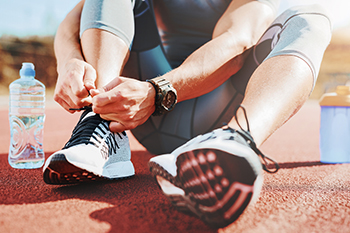
Participating in sports is not only fun, but it also supports physical fitness and teaches teamwork. However, sports can also be dangerous. Some sports like football, basketball, soccer, tennis, and running have more potential to lead to foot and ankle injuries than others. These sports have a high risk of causing Achilles tendonitis and ankle sprains, in addition to blisters, turf toe, stress fractures, metatarsal fractures, ankle impingement, and plantar fasciitis. Athletes can help prevent injuries by warming up, gradually increasing movement, wearing well-fitting footwear for their sport, and using other protective gear. If you suffer from a foot or ankle injury while playing sports, see a podiatrist for an informed diagnosis and treatment.
Sports related foot and ankle injuries require proper treatment before players can go back to their regular routines. For more information, contact Dr. Tupper of Coshocton Foot Health Center. Our doctor can provide the care you need to keep you pain-free and on your feet.
Sports Related Foot and Ankle Injuries
Foot and ankle injuries are a common occurrence when it comes to athletes of any sport. While many athletes dismiss the initial aches and pains, the truth is that ignoring potential foot and ankle injuries can lead to serious problems. As athletes continue to place pressure and strain the area further, a mild injury can turn into something as serious as a rupture and may lead to a permanent disability. There are many factors that contribute to sports related foot and ankle injuries, which include failure to warm up properly, not providing support or wearing bad footwear. Common injuries and conditions athletes face, including:
- Plantar Fasciitis
- Plantar Fasciosis
- Achilles Tendinitis
- Achilles Tendon Rupture
- Ankle Sprains
Sports related injuries are commonly treated using the RICE method. This includes rest, applying ice to the injured area, compression and elevating the ankle. More serious sprains and injuries may require surgery, which could include arthroscopic and reconstructive surgery. Rehabilitation and therapy may also be required in order to get any recovering athlete to become fully functional again. Any unusual aches and pains an athlete sustains must be evaluated by a licensed, reputable medical professional.
If you have any questions please feel free to contact our office located in Coshocton, OH . We offer the newest diagnostic and treatment technologies for all your foot and ankle needs.
Many Reasons for Swollen Feet
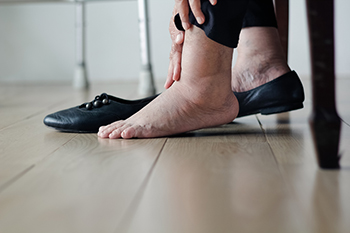
People who have swollen feet and ankles are generally aware of how uncomfortable they can be. There are various reasons why this can occur, including eating foods that have high levels of sodium, and taking certain medications. Additionally, pregnant women and people who are overweight may notice their feet are swollen, or it may happen as an allergic reaction from an insect bite. Mild relief can be found when salt intake is reduced in the diet, starting a gentle exercise routine, and frequently elevating the feet. It is beneficial to refrain from sitting or standing for long periods of time, in addition to wearing socks and shoes that are too tight. It can help to wear shoes that fit properly, and have a low heel and soft sole. Shiny skin on the feet can be a sign of edema, which is the medical term for swollen feet. Some people may experience a skin color change on their feet, and this may be a symptom of edema. If you have this condition, and you fail to find relief with the above suggestions, please consult with a podiatrist who can provide an examination and conclude with a proper diagnosis and treatment.
Swollen feet can be a sign of an underlying condition. If you have any concerns, contact Dr. Tupper of Coshocton Foot Health Center. Our doctor can provide the care you need to keep you pain-free and on your feet.
Swollen feet are a common ailment among pregnant women and people who stand or sit for extended periods. Aging may increase the possibility of swollen feet and patients who are obese often notice when their feet are swelling too. There may be medical reasons why swollen feet occur:
- Phlebitis - A condition that causes the veins to become inflamed and can also cause leg pain.
- Liver disease - This may lead to low blood levels of albumin which is a protein. This can cause fluid in the blood to pass into the tissues and several areas of the body can become swollen.
- Heart failure - When the heart doesn’t pump properly the blood that is normally pumped back to the heart can pool in the veins of the legs causing swollen feet.
- Kidney disease - One of the main functions of the kidneys is releasing excess fluid in the body. This type of condition can make it difficult for the kidneys to function properly, and as a result the feet may become swollen.
- Deep-vein thrombosis (DVT)- This is a serious condition where blood clots form in the veins of the legs. They can block the return of blood from the legs to the heart which may cause the feet to swell. It is important to be treated by a podiatrist if this condition is present.
Swollen feet can also be caused by bone and tendon conditions, including fractures, arthritis, and tendinitis. Additionally, there may be skin and toenail conditions and an infection may cause the feet to swell. Patients who take medicine to treat high blood pressure may be prone to getting swollen feet.
Many patients elevate their feet to help relieve the swelling and this is generally a temporary remedy. When a podiatrist is consulted the reason behind the swelling can be uncovered and subsequently treated.
If you have any questions please feel free to contact our office located in Coshocton, OH . We offer the newest diagnostic tools and technology to treat your foot and ankle needs.
Breaking Your Foot Is No Laughing Matter
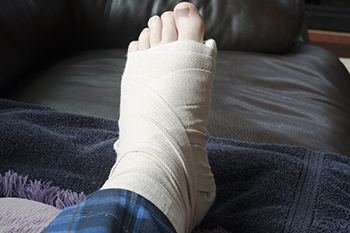
Though it can be funny to think of breaking your foot as a valid excuse to get out of going to an event you would rather skip, to actually break your foot is not funny at all. You can sustain a foot fracture from falling, moving quickly (such as in running or another sport), twisting your foot to one side, dropping something heavy on your foot, or enduring other injuries. When a fracture first happens, it is important to take weight off of the affected foot and elevate it. If you see a bone sticking out of your foot, your foot looks deformed in some other way, your foot is numb or cold, or you are in severe pain, make an appointment with a podiatrist as soon as possible. Your broken foot will usually be cast and/or put into a walking boot until it heals. Surgery may be required. A broken foot is something to take seriously. A podiatrist can ascertain the severity of the break and provide the best treatment option for you.
A broken foot requires immediate medical attention and treatment. If you need your feet checked, contact Dr. Tupper from Coshocton Foot Health Center. Our doctor can provide the care you need to keep you pain-free and on your feet.
Broken Foot Causes, Symptoms, and Treatment
A broken foot is caused by one of the bones in the foot typically breaking when bended, crushed, or stretched beyond its natural capabilities. Usually the location of the fracture indicates how the break occurred, whether it was through an object, fall, or any other type of injury.
Common Symptoms of Broken Feet:
- Bruising
- Pain
- Redness
- Swelling
- Blue in color
- Numbness
- Cold
- Misshapen
- Cuts
- Deformities
Those that suspect they have a broken foot shoot seek urgent medical attention where a medical professional could diagnose the severity.
Treatment for broken bones varies depending on the cause, severity and location. Some will require the use of splints, casts or crutches while others could even involve surgery to repair the broken bones. Personal care includes the use of ice and keeping the foot stabilized and elevated.
If you have any questions please feel free to contact our office located in Coshocton, OH . We offer the newest diagnostic and treatment technologies for all your foot and ankle needs.
More...
Why Live with Pain and Numbness in Your Feet?
Easy to Spot a Bunion
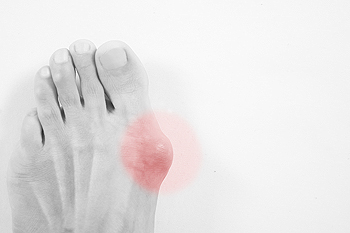
A bunion is easy to notice. It is classified as a deformity and is a bony protrusion on the side of the big toe. It can develop as a result of genetic factors or from wearing shoes that are too tight in the toe area. Research has shown it affects approximately 35% of people who are over 65 years old and may affect their quality of life if not promptly treated. The medical term for a bunion is called hallux valgus and happens when the first long bone of the foot meets the first bone of the toe. When this moves out of alignment, a bunion has formed. It often develops slowly and if it becomes severe it may shift the other toes toward each other. Flexibility and range of motion may negatively affect the foot, and the skin may become irritated. Some patients experience foot injuries, and this may lead to the development of a bunion. Additionally, existing medical conditions including flat feet and rheumatoid arthritis may increase the risk of getting a bunion. If you have noticed a bunion on your foot, it is strongly suggested that you are under the care of a podiatrist who can determine what the best course of treatment is for you, which may include surgery for permanent removal.
If you are suffering from bunions, contact Dr. Tupper of Coshocton Foot Health Center. Our doctor can provide the care you need to keep you pain-free and on your feet.
What Is a Bunion?
A bunion is formed of swollen tissue or an enlargement of boney growth, usually located at the base joint of the toe that connects to the foot. The swelling occurs due to the bones in the big toe shifting inward, which impacts the other toes of the foot. This causes the area around the base of the big toe to become inflamed and painful.
Why Do Bunions Form?
Genetics – Susceptibility to bunions are often hereditary
Stress on the feet – Poorly fitted and uncomfortable footwear that places stress on feet, such as heels, can worsen existing bunions
How Are Bunions Diagnosed?
Doctors often perform two tests – blood tests and x-rays – when trying to diagnose bunions, especially in the early stages of development. Blood tests help determine if the foot pain is being caused by something else, such as arthritis, while x-rays provide a clear picture of your bone structure to your doctor.
How Are Bunions Treated?
- Refrain from wearing heels or similar shoes that cause discomfort
- Select wider shoes that can provide more comfort and reduce pain
- Anti-inflammatory and pain management drugs
- Orthotics or foot inserts
- Surgery
If you have any questions, please feel free to contact our office located in Coshocton, OH . We offer the newest diagnostic and treatment technologies for all your foot care needs.
Changes to Your Feet as You Age
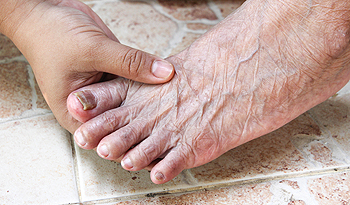
As people age, the body undergoes numerous changes, and changes to the feet are no exception. First, the skin becomes thinner, and you may notice joint pain you never had before from simple wear and tear. In addition, the muscles become weaker and less resilient. All this adds up to not being able to do many of the things that you used to do, or doing them more slowly and for shorter periods of time. Added to simply aging, certain conditions such as neuropathy, circulatory issues, and swelling of the feet (edema) may bring additional pain and increase the risk of injury or falling. The bones also begin to lose density, adding to the risk of fractures, especially in post-menopausal women. The fat pads in the heels and soles of the feet diminish, which may lead to such painful conditions as plantar fasciitis. Arthritis, an inflammation of the joints, may develop, causing more pain. Ways to stave off some of the effects of aging feet include finding footwear that fits properly and provides extra cushioning. Also, it is thought that foot and toe stretches help to keep the blood circulating and prevent swelling. Keeping your feet clean, dry, and moisturized can help you avoid infections. And watching your weight is important, as extra weight increases the load your feet have to support each time you take a step. For more information on taking care of your feet during your older years, please consult a podiatrist.
Proper foot care is something many older adults forget to consider. If you have any concerns about your feet and ankles, contact Dr. Tupper from Coshocton Foot Health Center. Our doctor can provide the care you need to keep you pain-free and on your feet.
The Elderly and Their Feet
As we age we start to notice many changes in our body, but the elder population may not notice them right away. Medical conditions may prevent the elderly to take notice of their foot health right away. Poor vision is a lead contributor to not taking action for the elderly.
Common Conditions
- Neuropathy – can reduce feeling in the feet and can hide many life-threatening medical conditions.
- Reduced flexibility – prevents the ability of proper toenail trimming, and foot cleaning. If left untreated, it may lead to further medical issues.
- Foot sores – amongst the older population can be serious before they are discovered. Some of the problematic conditions they may face are:
- Gouging toenails affecting nearby toe
- Shoes that don’t fit properly
- Pressure sores
- Loss of circulation in legs & feet
- Edema & swelling of feet and ankles
Susceptible Infections
Diabetes and poor circulation can cause general loss of sensitivity over the years, turning a simple cut into a serious issue.
If you have any questions please feel free to contact our office located in Coshocton, OH . We offer the newest diagnostic and treatment technologies for all your foot and ankle needs.
Keeping Senior Feet Healthy
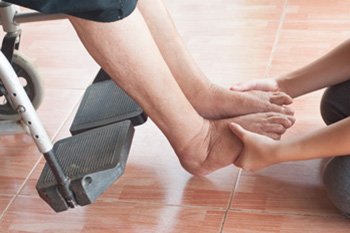
Healthy feet allow seniors to stay mobile and remain active and independent. Proper foot care is recommended for a lifetime but more importantly as one ages, as seniors are more prone to medical conditions and foot problems. For example, many seniors have diabetes and can be susceptible to nerve damage, infections, and poor circulation in their feet. Similarly, many in this age group suffer from some form of arthritis that causes foot pain. Daily foot care that will maintain the health of one’s feet include washing, drying, and moisturizing feet daily, and checking feet for cuts, blisters, or any problems that could lead to infection. Cutting toenails regularly and straight across to prevent ingrown toenails, wearing properly fitted footwear and soft cotton or wool socks to protect and cushion the feet, and staying active to maintain circulation in the legs and feet will also help. A podiatrist is a good medical professional to include on your healthcare team if you are a senior or providing care for the aged. Such a doctor can help in maintaining foot health, identify sources of foot discomfort, and suggest treatment options.
If you need your feet checked, contact Dr. Tupper of Coshocton Foot Health Center. Our doctor will attend to all of your foot and ankle needs and provide you with quality treatment.
Geriatrics and Podiatry
When people age, some common issues that may occur are bone density loss, dry skin, poor circulation, and rough brittle nails. These issues may also affect your foot health if the necessary steps are not taken to alleviate the problems.
It is important to take care of your feet because feet that are injured or diseased can affect your overall health. Having painful feet hinders your ability to do daily activities or may decrease your willingness to do the things that you need to do.
Visiting Your Geriatrician
As we age, health problems become more likely, so it is essential to visit your doctor for check-ups to ensure that you are doing the best you can to take care of your health. It is recommended to check your feet frequently for any possible cuts, bruises, swelling, corns or any other irregularities.
Taking Care of Elderly Feet
Cracked or dry feet can be treated by applying moisturizer often. It is also important not to wear old socks because the older the sock is, the higher the possibility there will be that there is bacteria there. Wear fresh socks and make sure they fit properly.
Proper foot health means that you can have a more active lifestyle and you will not be bogged down by pain. Foot health also leads to good circulation, which is paramount for overall health.
If you have any questions, please feel free to contact our office located in Coshocton, OH . We offer the newest diagnostic tools and technology to treat your foot and ankle needs.



